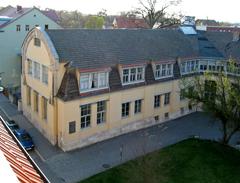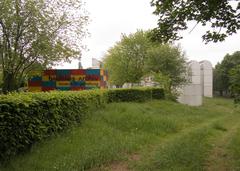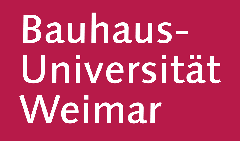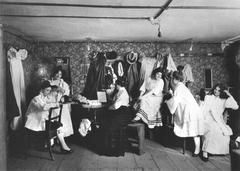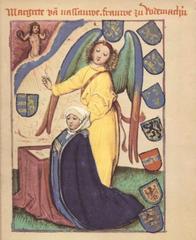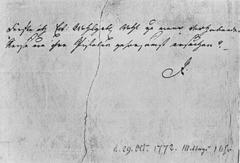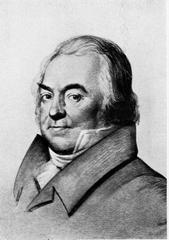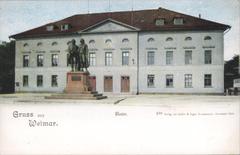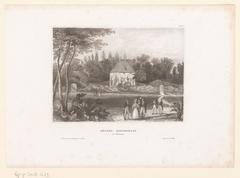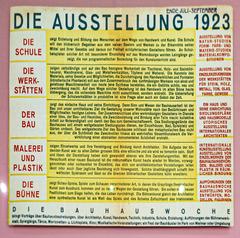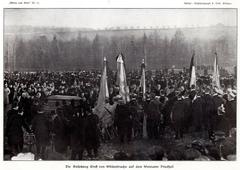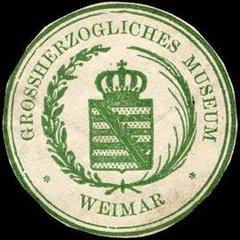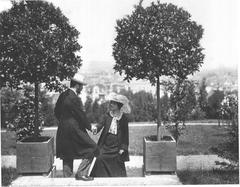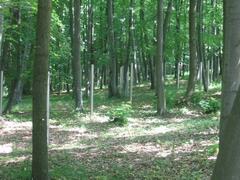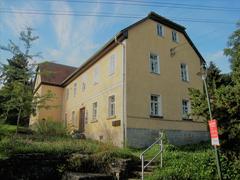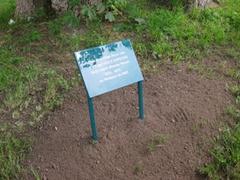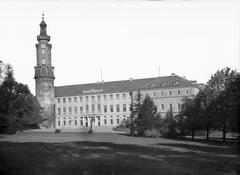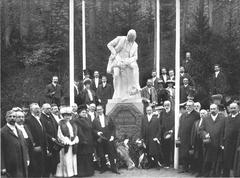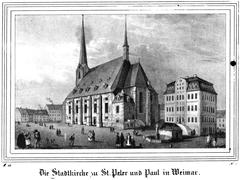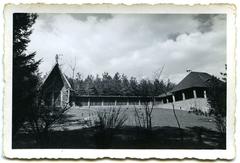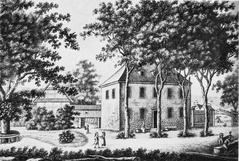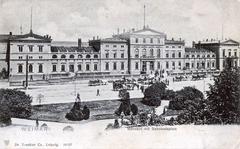
Gauforum Weimar: Comprehensive Guide to Visiting Hours, Tickets, and Historical Insights
Date: 04/07/2025
Introduction
The Gauforum Weimar stands as one of Germany’s most significant and imposing historical sites, offering a profound window into the architectural ambitions and ideological narratives of the National Socialist era. Conceived in the late 1930s as a regional administrative and propaganda center, this monumental neoclassical complex was designed by Hermann Giesler under the directive of Adolf Hitler. Today, the Gauforum serves a dual function: while it continues to house government offices, it also operates as an essential site of remembrance and education, particularly through the Museum of Forced Labor under National Socialism.
With free admission, accessible facilities, and central location near Weimar’s historic center and train station, the Gauforum is a key destination for history enthusiasts, architecture aficionados, and cultural travelers. Guided tours, multilingual resources, and proximity to sites such as the Bauhaus Museum and Goethe’s Residence make it an integral part of any visit to Weimar.
This comprehensive guide provides essential information for your visit, including historical context, architectural highlights, visiting hours, ticket details, accessibility, and practical travel tips. For the most current information, consult the Gauforum official site and the Museum of Forced Labor.
Contents
- History and Cultural Significance
- Architectural Vision and Urban Context
- Design Principles and Monumental Traditionalism
- Site Layout and Architectural Features
- Symbolism and Propaganda
- Construction and Materials
- Postwar Adaptation and Contemporary Use
- Visitor Information
- Visiting Hours and Tickets
- Accessibility
- Guided Tours and Special Events
- On-site Facilities
- Directions and Transportation
- Nearby Attractions and Travel Tips
- Special Events and Educational Programs
- Safety, Etiquette, and Photography
- Frequently Asked Questions (FAQ)
- Contact Information
- Conclusion and Planning Resources
- Sources
History and Cultural Significance
The Gauforum Weimar was envisioned in the late 1930s as a monumental administrative and ceremonial center for the Nazi Party’s regional leadership. Its construction began in 1936 after the demolition of a significant portion of Weimar’s Jakobvorstadt district and the rerouting of the Asbach river. The complex was designed to symbolize the power and permanence of the National Socialist regime, with Fritz Sauckel—Gauleiter of Thuringia and notorious for orchestrating forced labor deportations—serving as its primary occupant (bauhauskooperation.com; regiopia.com).
Although only partially completed before WWII ended, the Gauforum’s imposing architecture and central square (originally “Adolf Hitler Platz,” now Weimarplatz) remain as a stark reminder of the era’s ambitions and atrocities. Today, the site is dedicated to critical reflection, especially through exhibitions that address the forced labor system and other aspects of the Nazi regime (Museum of Forced Labor).
Architectural Vision and Urban Context
Design Principles and Monumental Traditionalism
Rejecting modernist influences like the Bauhaus, which originated in Weimar, the Gauforum exemplifies “monumental traditionalism.” Its neoclassical style, characterized by massive stone facades and colonnades, was intended to project timeless authority, unity, and power (brill.com; regiopia.com).
Site Layout and Architectural Features
The complex was planned as a four-part ensemble:
- NSDAP Gauleitung Administrative Building
- Hall of the People’s Community (“Halle der Volksgemeinschaft”), designed for 20,000 people
- Bell Tower (half its intended height was completed)
- Central Parade Ground (Weimarplatz)
Three administrative buildings, the bell tower, and the assembly hall were partially or fully completed by 1945 (bauhauskooperation.com). The axial, symmetrical design facilitated mass rallies and reinforced the regime’s ideals of discipline and collective identity.
Symbolism and Propaganda
The Gauforum’s architecture was a deliberate tool of propaganda, designed to awe and subdue. Its scale, symmetry, and classical references served to legitimize the regime and reinforce the subordination of the individual to the collective—a hallmark of Nazi ideology (brill.com).
Construction and Materials
Built primarily with traditional masonry and stone cladding for durability, construction was interrupted by wartime shortages and only three of the five planned buildings were finished by 1945. Postwar, the assembly hall was repurposed as a shopping center (regiopia.com).
Postwar Adaptation and Contemporary Use
After WWII, the complex saw various uses: it was occupied by Soviet forces and later adapted for civic functions under the East German government. Since reunification, the Gauforum has housed Thuringian state administration offices, the State Office for Environment, and the Museum of Forced Labor (bauhauskooperation.com). The assembly hall is now the Weimar Atrium shopping center, and the central square incorporates an underground car park, reflecting the city’s evolving needs.
Visitor Information
Visiting Hours and Tickets
- Permanent exhibition: Open Tuesday–Sunday, 10:00 AM–5:00 PM (some sources indicate 10:30–16:30; verify via official site).
- Museum of Forced Labor: Open Tuesday–Sunday and public holidays, 10:00 AM–6:00 PM; closed Mondays, December 24–26, December 31, and January 1 (Museum of Forced Labor).
- Admission: Generally free; some special exhibitions or guided tours may require a fee.
Accessibility
The complex is wheelchair accessible, with ramps, elevators, and accessible restrooms throughout. Staff are available to assist visitors with special needs.
Guided Tours and Special Events
Regular guided tours in German and English offer in-depth insights into the Gauforum’s history and architecture. Tours and educational programs for groups and schools can be arranged in advance. The museum also hosts temporary exhibitions, lectures, and commemorative events (Gauforum.de).
On-site Facilities
- Cloakroom and lockers
- Rest areas and seating
- Information desk
- Museum shop (books, educational materials, souvenirs)
- Restrooms
- Refreshments at nearby cafes and within the Weimar Atrium shopping center (regiopia.com)
Directions and Transportation
- Location: Jorge-Semprún-Platz 2, 99423 Weimar
- Public transport: Short walk from Weimar’s main train station and city center; bus and tram stops nearby.
- Parking: Limited parking available; public transport recommended (bauhauskooperation.com).
Nearby Attractions and Travel Tips
Combine your visit to the Gauforum with other Weimar highlights:
- Bauhaus Museum: Explore the origins of modernist design.
- Goethe National Museum: Visit the home of Germany’s literary giant.
- Duchess Anna Amalia Library: Renowned for its Rococo architecture and literary treasures.
- Weimar Historic Center: UNESCO World Heritage, filled with museums and charming streets.
Travel tips:
- Wear comfortable shoes; the site and nearby attractions require walking.
- Allow 1.5–2 hours for your visit.
- Download the Audiala mobile app for audio guides and updated event info.
- Check the official website for current exhibitions and events.
Special Events and Educational Programs
The Gauforum regularly hosts special exhibitions, workshops, talks, and forums focused on remembrance, human rights, and the legacy of forced labor. Check the Museum of Forced Labor Events calendar or inquire at the information desk for details.
Safety, Etiquette, and Photography
- Safety: Follow posted guidelines; emergency exits and trained staff ensure a secure visit.
- Etiquette: Maintain quiet reflection and respect the memorial nature of the site. Prepare children for sensitive exhibition content.
- Photography: Allowed in most public areas, but may be restricted in certain exhibitions; check signage or ask staff.
Frequently Asked Questions (FAQ)
Q: What are the Gauforum Weimar visiting hours?
A: Generally, Tuesday–Sunday between 10:00 AM and 5:00 PM; specific museum hours may vary. Check the official website for updates.
Q: Are tickets required?
A: Admission is usually free; some special exhibitions or tours may charge a fee.
Q: Is the Gauforum accessible for wheelchair users?
A: Yes, the site is fully accessible, with ramps and elevators.
Q: Are guided tours available in English?
A: Yes, advance booking is recommended.
Q: Can I take photos?
A: Generally permitted in public areas; restrictions may apply in some exhibitions.
Q: Where can I park?
A: Limited parking nearby; public transportation is advised.
Contact Information
Museum of Forced Labor under National Socialism
- Address: Jorge-Semprún-Platz 2, 99423 Weimar
- Phone: +49 (0)3643 8 777 288
- Email: [email protected]
- Website: museum-zwangsarbeit.de
Tourist Information Weimar
- Phone: +49 (0) 361 / 380 395 - 200
- Email: [email protected]
- Website: weimar-touristinformation.de
Conclusion
A visit to the Gauforum Weimar offers a compelling journey through Germany’s turbulent history, from its architectural manifestation of totalitarian ambition to its transformation into a site of education and remembrance. The Gauforum’s exhibitions, tours, and events provide critical engagement with themes of forced labor, propaganda, and urban renewal, while its accessible and central location makes it an essential addition to any Weimar itinerary.
Before your visit, check current opening hours, book tours in advance, and explore multimedia resources for a deeper experience. The Gauforum Weimar stands today as both a witness to the past and a living reminder of the importance of confronting history with openness and responsibility.
Download the Audiala app for guided tours, follow us on social media for updates, and plan your exploration of Weimar’s extraordinary heritage.
Sources
- Visiting the Gauforum Weimar: History, Tickets, Hours, and Tips, 2025, Audiala (https://www.gauforum.de/)
- Gauforum Weimar: Visiting Hours, Tickets, and Historical Significance of Weimar’s Nazi-Era Monument, 2025, Bauhaus Kooperation (https://bauhauskooperation.com/reisen/orte/ortsdetailseite/ort-158)
- Gauforum Weimar: Visiting Hours, Tickets, and Exploring Weimar’s Historical Sites, 2025, Gauforum.de (https://www.gauforum.de/)
- Gauforum Weimar Visiting Hours, Tickets, and Visitor Guide to Weimar Historical Sites, 2025, Museum of Forced Labor (https://www.museum-zwangsarbeit.de/en/besuch)
- Regiopia: Gauforum Weimar Information, 2025 (https://regiopia.com/europe/germany/weimar/sights-weimar.html)
- Stadt Weimar: Exhibition ‘Das Gauforum in Weimar – Ein Erbe des Dritten Reiches’ 2025 (https://stadt.weimar.de/de/aktuelle-meldungen/ausstellung-das-gauforum-in-weimar-ein-erbe-des-dritten-reiches-oeffnet-wieder.html)
- Brill: Architectural and Historical Analysis of Gauforum Weimar, 2025 (https://brill.com/view/journals/fasc/12/2/article-p306_10.xml)

